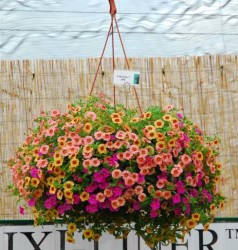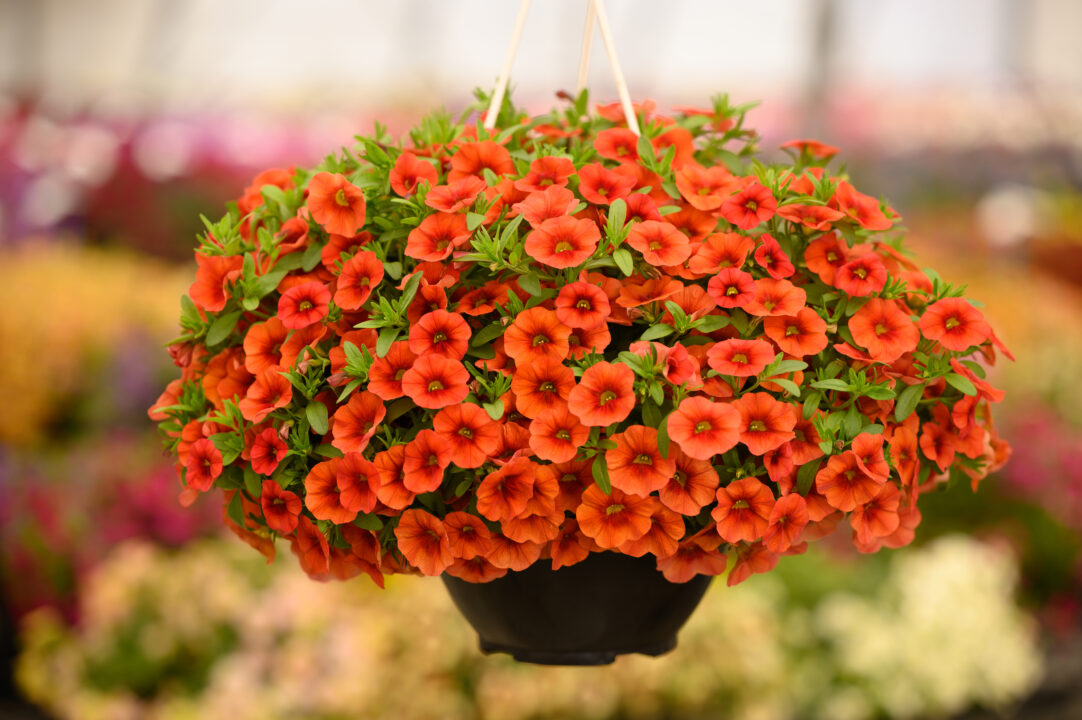The More, The Merrier

Mixing the unrooted cuttings of three different cultivars into one liner just makes sense, doesn’t it? It does for breeders Dömmen USA and Selecta First Class. Now growers across the country can get more bang for their buck, while cutting back on time and labor.
The Confetti liner, created by the Dömmen USA team, is made up of two or three cuttings from one or multiple plant genera rooted together in one 40-millimeter Ellepot. Rebecca Lusk, regional sales manager of Dömmen USA, says the Confetti liners are “already prepared for instant success.” The liner comes in trays of 50 and in pinched combinations of cailbrachoas, petunias and verbenas, all of which match in color, timing and vigor.
Before launching the Confetti program, Dömmen trialed numerous cultivars for two years. “We were determined to invent an easy way to create color combinations for growers challenged with the creation, balance and timing of hanging baskets and large deco pots,” Lusk says.
Selecta’s TrixiLiner comes in its standard size 72-cell tray with three unrooted cuttings in each cell. This liner is pinched, treated with a plant growth regulator (PGR) and hardened for dispatch. This pre-selected idea came from their larger MiniFamous licensees in Japan, which mixed three varieties in their finished pot production.
For 2009, the TrixiLiner will include pure calibrachoa mixes and six mixes of varied verbenas, petunias and calibrachoas.
“We started with 35 recipes and three different trays,” says Stefan Reiner, general manager of Selecta First Class. “We selected at the end the best 10 recipes and decided on the 72-cell tray for good reasons.” Tight spacing in the 72-cell trays forces the cuttings to grow upright. This guided growth pattern makes for easier handling of the product. Selecta tried a 50-cell tray to no avail, and found many of the plants grew flat.
“Because of the upright growth, plants didn’t intermingle and planting was a breeze,” Reiner says. They also found the 72-cell format saves on shipping costs significantly. “We will charge one royalty per liner, which is not as high as three individual royalties will be.”
Resourceful Combinations
In addition to this ingenious concept, Confetti liners and TrixiLiners provide growers a cost-efficient route to creating baskets and containers. “It takes out the guessing game and avoids surprises at the end,” Reiner says. “We see the biggest savings in labor when handling mixed baskets or pots, and reliability is much better.”
Dömmen’s Rebecca Lusk explains the Confetti liners use up less space on the bench, especially compared to using 4-inch pots for the same outcome. These liners also allow for a quicker turnaround–start later and finish earlier–which dramatically
reduces the grower’s overhead and labor, thanks to the easy transplanting.
In line with time and labor savings, Lusk adds that pre-planting the mixes makes these combination liners extremely reliable, taking catalogs, designers and surprises out of the equation. “Too many times, growers tell their staff to mix certain products together and they often get something different because the staff wasn’t listening, paying attention, or just ran out of a variety,” Reiner says.
In the end, they save on plastic, freight, heating, time and even lost sales. “You have to know timing and vigor on all cultivars. Getting the timing off by one week can be the difference between a sale,” Lusk says.
So Far, So Good
For both breeders, feedback has been overwhelmingly positive. “Some growers are scratching their heads saying, ‘Now, why did I not think of that?'” Lusk says. Reiner agrees. “Right now we get great feedback from all types of growers, like independent garden centers, small- and medium-sized growers, and even larger super growers are interested,” he says. “We even have interest from a mail order company for consumers and from retail chains.”









